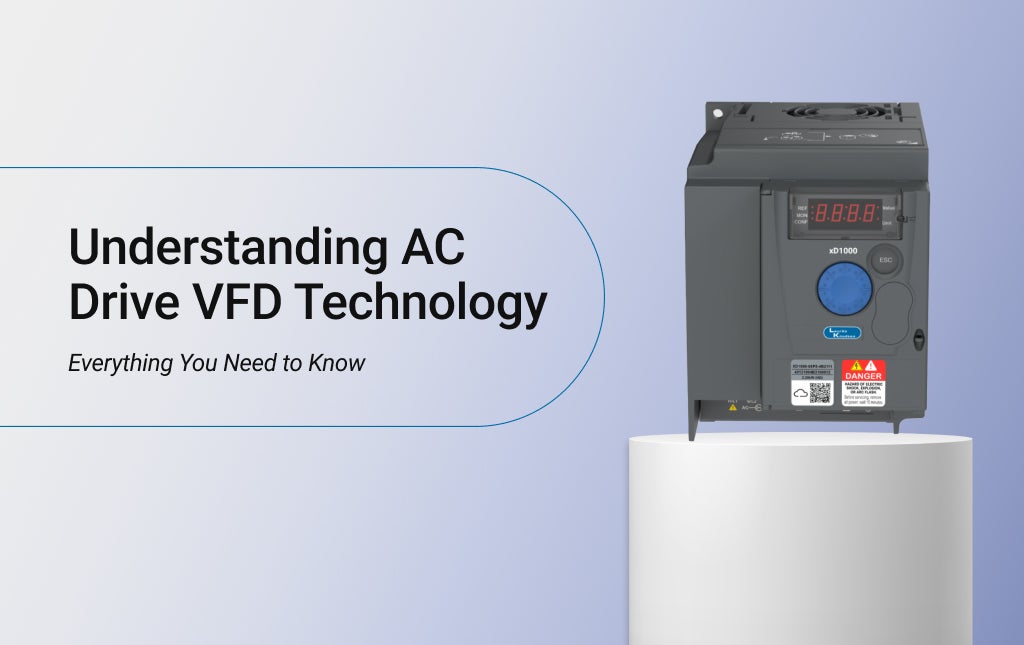Understanding AC Drive VFD Technology: Everything You Need to Know

In the HVAC industry, VFDs or AC drives are predominantly seen. VFDs stands for variable frequency drive. They have a wide utility across various sectors. From residential and commercial to healthcare and educational buildings, we can see the installation of VFDs. Since they control the AC motors, they are often referred to as AC drive VFD. Let’s learn everything about VFDs.
What is variable frequency drive?
Also known as AC drives, microdrives, inverters, adjustable frequency drives, and variable frequency drives (VFDs), variable frequency drives control the AC motors by changing their frequency and voltage. The AC motor VFD is used as a substitute for electric motors to turn up or down the appliance's speed. This controller is used in industrial setups, healthcare and educational organisations, and more.
What is the function of an AC drive?
An AC drive is an electronic mechanism that converts a fixed frequency and voltage to an adjustable frequency and voltage source. Widely known as variable frequency drive, it also controls the torque, speed, direction, and horsepower of an AC motor. To describe a specific section of an AC drive, it is referred to as an AC inverter. This section converts the DC voltage into an AC voltage with a particular frequency. The DC to AC VFD drives are gaining popularity these days due to the energy savings associated with AC technology. Technological advancements have made AC drives more desirable in industrial variable speed applications because of their size, affordability, dependability, and performance.
What are the different types of VFD drives?
Variable frequency drives can be categorised as electrical drives, which are of three types:
1. Eddy-current Coupling
It is a type of VFD that is placed between the constant-speed motor and the motor-driven application. This has both fixed and variable speed motors. A little air gap separates both of these components.
2. DC Drives
DC drives use a DC converter to convert an alternating current power source into a variable-amplitude DC voltage. This voltage is applied to the armature winding of the corresponding DC motor. These drives utilise thyristor technology and are utilised in a variety of applications.
3. AC Drives
AC drives involve an AC converter to change the DC variable into AC. AC drives further have three types: Voltage source, current source, and direct conversion drive.
What is a VFD for 3 phases?
For residential and agricultural settings, single phase AC drives or VFDs are mostly common. However, to save more energy, three-phase VFDs can be utilised. A 3 phase AC drive will obviously be connected to three phases to speed control AC motors like fans, pumps, shop tools and more. Three-phase power is typically used in 240 and 480 VAC systems. However, in many instances, up to 600 VAC systems are also used. One can power a three-phase AC motor with a single-phase; however, phase conversion is a tricky business, and not every single-phase drive can control the speed of a three-phase motor. Thus, one must check the credentials of the drive before using it.
What are AC and DC drives?
AC drive stands for Alternating Current Drive, a type of electric drive used for controlling the speed of an AC motor (certainly three-phase induction motors). The operation of an AC drive can be described in the following steps:
- AC drives use a rectifier circuit to convert AC current into DC current.
- It uses the inverter circuit to invert the DC back to AC to control the speed of the AC motor.
AC drives are also known as variable frequency drives or VFD controllers for AC motors as it changes the frequency and voltage of the AC supply.
DC drive stands for Direct Current Drives. It is also a type of electric drive used to control the speed of a DC motor. This drive converts AC supply input to DC supply to control the speed of the DC motor using the rectifier circuit. DC drives have two types: analogue DC drives and digital DC drives.
How Variable Frequency Drives Work in HVAC Systems?
HVAC (heating, ventilation and air-conditioning systems) operate at the peak load, which happens only for a short period. To improve the energy efficiency of HVAC VFD is used. These electrical drives, including pumps, fans and compressors, are widely used in the sector. VFDs have proved to be effective in adjusting the speed of AC motors by changing their voltage and frequency.
Conclusion
In various industries, especially in HVAC systems, VFDs are used to control the speed of the AC motor by changing their voltage and frequency. It also helps save energy and thereby money on electricity. There are various kinds of VFDs available in the market for single-phase or three-phase AC motors. But, it is important to check the supply before infusing one.
Lauritz Knudsen AC Drive Solutions
Lauritz Knudsen comes with a VFD controller for AC motors backed by advanced technology. Our AC drive solutions have been used in various industries and sectors for over two decades now. Lauritz Knudsen sx2000 VFD has made its mark in Indian industries used in applications like pharmaceutical, textile, plastic, elevator, cement, and more. Our VFDs are globally compliant, and up to 5 fault histories can be viewed.
FAQs
1. Can a VFD be used in an AC motor?
VFD, or variable frequency drive, is a device that is used to change the frequency and voltage of an AC motor. So, yes, it can be used in an AC motor.
2. Where are AC drives used?
AC drives are used in industries which have cooling systems and water pumps. AC drives, also called VFDs or inverters, change a current input into AC output.
3. What is the difference between DC and AC drive?
DC drives have high torque and are used when constant speed is required. On the other hand, AC drives are used in circumstances where the torque, horsepower, voltage and frequency of the electrical system varies.


